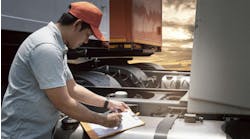Wherever possible, New York City will be looking to move from standard heavy trucks in its fleet to "high vision" trucks with extended windows/ better visibility for the operator and minimal blind spots. Lower-height truck cabs, trucks with hoods that are easier to see over, and cabover trucks also offer advantages, the city believes.
"Things as simple as vehicle design can reduce blind spots and prevent tragic collisions," noted Lisette Camilo, commissioner of the NYC Dept. of Citywide Administrative Services (DCAS).
When there's an available option for it, the city will purchase "high vision" tow trucks, garbage trucks, dump trucks, and other vehicle types. DCAS provided an illustration of high vision options (see below) showing what looks to be a Mack LR refuse truck—which has a number of window and cab features designed to improve visibility—fitted with a dump body.
City officials pointed to a study from London that found vehicle reaction times are 70% slower in traditional trucks vs. high vision alternatives.
NYC estimates it has "at least 2,500" conventional trucks that could transition to high-vision units. DCAS noted that many emergency service vehicles like fire engines, ladders, and some police vehicles already have high-vision designs.
Keith Kerman, deputy commissioner of DCAS and NYC's chief fleet officer, took it a step further, calling for high vision safety features to be put in place and made standard on trucks whenever possible.
"These technologies save lives and money and should be standard on all base fleet vehicles," he said. "DCAS calls on the fleet industry to separate safety options from luxury items in marketing vehicles."
DCAS said it is making this vehicle transition to help protect pedestrians and cyclists in the dense, tight environments in which NYC fleet trucks often operate. It's part of Mayor Bill de Blasio's Vision Zero initiative to end traffic deaths and injuries.
The initiative also includes:
—Expanded enforcement of moving violations like speeding and failing to yield to pedestrians;
—New street configurations designed to improve safety;
—Public outreach and communication; and
—A legislative agenda to increase penalties for dangerous drivers.





